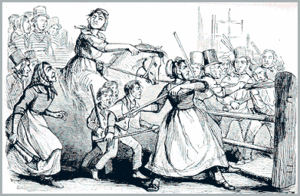বেশান্তৰ
বেশান্তৰ বা ক্ৰছ ড্ৰেছিংৰ দ্বাৰা পৰস্পৰ বিপৰীত লিংগৰ সৈতে সম্পৰ্কিত নিৰ্দিষ্ট সমাজ নিৰ্ধাৰিত সাজ-সজ্জা পৰিধান কৰাক বুজোৱা হয়।[1] আধুনিক বিশ্বত তথা সমগ্ৰ বিশ্বৰ ইতিহাসত ছদ্মবেশ, স্বাচ্ছন্দ্য, কৌতুক অভিনয় আৰু আত্মপ্ৰকাশৰ উদ্দেশ্যে ক্ৰছ-ড্ৰেছিং ব্যৱহাৰ কৰি অহা হৈছে।
পৃথিৱীৰ প্ৰায় প্ৰতিখন মানৱ সমাজে তেওঁলোকে পিন্ধিব বিচৰা শৈলী, ৰং বা প্ৰকাৰৰ পোছাকৰ সৈতে সম্পৰ্কিত প্ৰতিটো লিংগৰ বাবে সুকীয়া নিয়ম আশা কৰিছিল, আৰু একেদৰে বেছিভাগ সমাজে প্ৰতিটো লিংগৰ বাবে কেনে ধৰণৰ পোছাক উপযুক্ত সেইটো নিৰ্ধাৰণ কৰা নিৰ্দেশনা, দৃষ্টিভংগী বা আইনৰ এক সংহতি আছে।
পৰিভাষা
[সম্পাদনা কৰক]ক্ৰছ ড্ৰেছিং ৰ বিষয়ে হিব্ৰু বাইবেলত লিপিবদ্ধ হৈছে। [2] এই অভিধাটোক বৰ্ণনা কৰাৰ চৰ্তাৱলী বিভিন্ন সময়ত সলনি হৈ আহিছে। এংলো-চেক্সন-মূলৰ শব্দ "ক্ৰছ-ড্ৰেচাৰ"-এ মুখ্যতঃ লেটিন মূলৰ "ট্ৰেন্সভেষ্টিট" শব্দটোক অতিক্ৰম কৰি অৰ্থ প্ৰকাশ কৰে। যিটো পুৰণি আৰু অপমানজনক। [3][4][5] ইয়াৰ কাৰণ হৈছে ট্ৰেন্সভেষ্টিট শব্দটো ঐতিহাসিকভাৱে একপ্ৰকাৰৰ মানসিক ৰোগক বুজাবলৈ ব্যৱহাৰ কৰা হৈছিল (যেনে ট্ৰেন্সভেষ্টিক ফেটিচিজম), আনহাতে ক্ৰছ-ড্ৰেচাৰ শব্দটো ট্ৰেন্সজেণ্ডাৰ সম্প্ৰদায়ৰ দ্বাৰা সৃষ্ট। [3][6] অক্সফৰ্ড ইংৰাজী অভিধানে ১৯১১ চনত এডৱাৰ্ড কাৰপেণ্টাৰে "ক্ৰছ-ড্ৰেছিং" শব্দটোৰ প্ৰাথমিক উদ্ধৃতি হিচাপে ব্যৱহাৰ কৰিছে: "ক্ৰছ ড্ৰেছিংক সমকামিতাৰ এক সাধাৰণ ইংগিত বাহক আৰু এক চেতন পৰিঘটনা হিচাপে ল'ব লাগিব।"
ইতিহাস
[সম্পাদনা কৰক]
লিপিবদ্ধ ইতিহাসৰ বিভিন্ন অধ্যায়ত, সমাজত, আৰু বহুতো কাৰণত ক্ৰছ-ড্ৰেছিং প্ৰচলিত হৈ আহিছে। গ্ৰীক, নৰ্ছ আৰু হিন্দু পৌৰাণিক কাহিনীত ইয়াৰ বিভিন্ন উদাহৰণ বিদ্যমান। লোককাহিনী, সাহিত্য, থিয়েটাৰ আৰু সংগীত, যেনে কাবুকি আৰু কোৰিয়ান শ্বামানবাদত ক্ৰছ ড্ৰেছিঙৰ ব্যৱস্থা প্ৰচলিত। শংকৰদেৱৰ দ্বাৰা প্ৰচলিত ভাওনা সংস্কৃতিটো নাটক সমূহৰ মহিলা চৰিত্ৰ সমূহ ৰূপায়ণ কৰিবলৈ পুৰুষ সকলেই বেশান্তৰৰ দ্বাৰা অভিনয় কৰিছিল।

১৮৩৯ চনৰ পৰা ১৮৪৩ চনৰ ভিতৰত পশ্চিম আৰু মিড ৱেলছত ৰেবেকা দাঙ্গা সংঘটিত হৈছিল। [7] ই আছিল স্থানীয় কৃষক আৰু কৃষি কৰ্মীসকলে অন্যায় কৰৰ প্ৰতিক্ৰিয়াস্বৰূপে কৰা এক শৃংখলাবদ্ধ প্ৰতিবাদ। প্ৰতিবাদকাৰী সকলৰ প্ৰায়ে মহিলাৰ পোছাক পিন্ধি প্ৰতিবাদত বহিছিল। প্ৰতিবাদকাৰীসকলে হিংসা পৰিহাৰ কৰাৰ উদ্দেশ্যে বাইবেলৰ চৰিত্ৰ ৰেবেকাৰ ছদ্মবেশ গ্ৰহণ কৰিছিল। [8]পিছত ১৮৪৪ চনত ৱেলছত টাৰ্ণপাইক ট্ৰাষ্ট সম্পৰ্কীয় আইনসমূহ একত্ৰিত আৰু সংশোধন কৰাৰ বাবে সংসদৰ এখন আইন গৃহীত হয়।
হিন্দু পুৰাণ সমূহত বেশান্তৰ এটা সাধাৰণ ঘটনা। ৰামায়ণৰ উত্তৰকাণ্ডত ৰজা ইলাৰ কাহিনীত ভগৱান শিৱক পাৰ্বতীৰ সৈতে নাৰীৰ ৰূপত জলকেলি কৰিথকা দেখুওৱা হৈছে। সমুদ্ৰ মন্থনত বিষ্ণুৱে অসুৰসকলক লক্ষ্য কৰি মোহিনী নামৰ এগৰাকী সুন্দৰী নাৰীৰ ৰূপ লৈছিল।[9] মহাভাৰতত বহুতো গুৰুত্বপূৰ্ণ ঘটনা বেশান্তৰৰ সৈতে সম্পৰ্কিত। অৰ্জুনে মৎস্য ৰাজ্যত বৃহন্নলা নামৰ এগৰাকী মহিলা নৃত্যশিল্পীৰ ছদ্মবেশত প্ৰায় এবছৰ কাল অতিবাহিত কৰিছিল। সেই সময়ত অৰ্জুন অজ্ঞাতবাসত আছিল।[10] ৰজা দ্ৰুপদৰ জীয়ৰী শিখণ্ডীয়ে এজন পুৰুষৰ বেশত যুদ্ধত অংশগ্ৰহণ কৰিছিল। আকৌ মৌশাল পৰ্বত যাদৱসকলে কৃষ্ণৰ পুত্ৰ শ্বাম্বক বলপূৰ্বকভাৱে গৰ্ভৱতী মহিলা ৰূপত সজাই উপহাস কৰিছিল।
সামাজিক প্ৰেক্ষাপট
[সম্পাদনা কৰক]ক্ৰছ-ড্ৰেচাৰসকলে শৈশৱতে সহোদৰ, পিতৃ-মাতৃ বা বন্ধুৰ কাপোৰ ব্যৱহাৰ কৰি বিপৰীত লিংগৰ সৈতে সম্পৰ্কিত পোছাক পিন্ধিবলৈ আৰম্ভ কৰিবও পাৰে। কিছুমান অভিভাৱকে তেওঁলোকৰ সন্তানক ক্ৰছ-ড্ৰেছৰ অনুমতি দিয়ে আৰু বহুক্ষেত্ৰত, শিশুটো ডাঙৰ হোৱাৰ পিছত এইধৰণৰ পৰিধান বন্ধ কৰে। একেধৰণৰ আৰ্হি প্ৰায়ে প্ৰাপ্তবয়স্কৰ ক্ষেত্ৰটো থাকে, আৰু ইয়াৰ পৰিণতিত পত্নী, সঙ্গী, পৰিয়ালৰ সদস্য বা বন্ধুৰ সৈতে সংঘাত হ'ব পাৰে। বিবাহিত ক্ৰছ-ড্ৰেচাৰসকলে পত্নীৰ অসমৰ্থনত এইক্ষেত্ৰত যথেষ্ট উদ্বেগ আৰু অপৰাধ অনুভৱ কৰিব লগাত পৰে।
কেতিয়াবা অপৰাধ বা আন কাৰণৰ বশৱৰ্তী হৈ ক্ৰছ-ড্ৰেচাৰসকলে তেওঁলোকৰ সকলো সাধাৰণ পোছাক নষ্ট কৰি পেলায়। এই অৱস্থাটোক "প্ৰুজিং" প্ৰথা বুলি কোৱা হয়। ইয়াৰ লগেলগে সেই ব্যক্তিয়ে কেৱল বিপৰীত লিংগৰ পোছাক পুনৰ সংগ্ৰহ কৰা আৰম্ভ কৰে।[11]
উৎসৱ
[সম্পাদনা কৰক]বিভিন্ন সংস্কৃতিত উৎসৱ স্বৰূপে ক্ৰছ-ড্ৰেছিং উদযাপন কৰা প্ৰথাৰ প্ৰচলন আছে। কোট ডি'আইভ'ৰৰ আবিচা উৎসৱ,[12] জাপানৰ ওফুদামাকি,[13] আৰু ভাৰতৰ কোট্টাংকুলাঙ্গাৰা,[14] এনে উৎসৱৰ উদাহৰণ।
তথ্যসূত্ৰ
[সম্পাদনা কৰক]- ↑ "cross-dress." The American Heritage Dictionary of the English Language, Fourth Edition. Houghton Mifflin Company, 2016.
- ↑ Aggrawal, Anil. (April 2009). "References to the paraphilias and sexual crimes in the Bible". J Forensic Leg Med খণ্ড 16 (3): 109–14. doi:10.1016/j.jflm.2008.07.006. PMID 19239958.
- ↑ 3.0 3.1 Annemarie Vaccaro, Gerri August, Megan S. Kennedy (2011). Safe Spaces: Making Schools and Communities Welcoming to LGBT Youth. ABC-CLIO. পৃষ্ঠা. 142. ISBN 978-0313393686. https://books.google.com/books?id=ZkxjSnI2e0UC&pg=PA142। আহৰণ কৰা হৈছে: October 21, 2016. "Cross-dresser/cross-dressing. (1) The most neutral word to describe a person who dresses, at least partially or part of the time, and for any number of reasons, in clothing associated with another gender within a particular society. Carries no implications of 'usual' gender appearance, or sexual orientation. Has replaced transvestite, which is outdated, problematic, and generally offensive since it was historically used to diagnose medical/mental health disorders."
- ↑ Jamie C. Capuzza, Leland G. Spencer (2015). Transgender Communication Studies: Histories, Trends, and Trajectories. Lexington Books. পৃষ্ঠা. 174. ISBN 978-1498500067. https://books.google.com/books?id=A1emBgAAQBAJ&pg=PA174। আহৰণ কৰা হৈছে: October 21, 2016. "Eventually, the transvestite label fell out of favor because it was deemed to be derogatory; cross-dresser has emerged as a more suitable replacement (GLAAD, 2014b)."
- ↑ Charles Zastrow (2016). Empowerment Series: Introduction to Social Work and Social Welfare: Empowering People. Cengage Learning. পৃষ্ঠা. 239. ISBN 978-1305388338. https://books.google.com/books?id=DB5TCwAAQBAJ&pg=PA239। আহৰণ কৰা হৈছে: October 21, 2016. "the term transvestite is often considered an offensive term."
- ↑ David A. Gerstner (2006). Routledge International Encyclopedia of Queer Culture. Routledge. পৃষ্ঠা. 568. ISBN 978-0313393686. https://books.google.com/books?id=XS_SnVPixE8C&pg=PA568। আহৰণ কৰা হৈছে: October 21, 2016. "A variety of derogatory terms are still used to describe any aspect of the transgender condition. [...] The term transvestite being older [than cross-dresser] and associated with the medical community's negative view of the practice, has come to be seen as a derogatory term. [...] The term cross-dresser, in contrast, having come from the transgender community itself, is a term seen as not possessing these negative connotations."
- ↑ Davies, John; Jenkins, Nigel (2008). The Welsh Academy Encyclopaedia of Wales. প্ৰকাশক Cardiff: University of Wales Press. পৃষ্ঠা. 730. ISBN 978-0-7083-1953-6.
- ↑ Gross, David M. (2014). 99 Tactics of Successful Tax Resistance Campaigns. Picket Line Press. পৃষ্ঠা. 68–69. ISBN 978-1490572741.
- ↑ Goudriaan, p. 44, Adi Parva (chapter 17, stanzas 38–40)
- ↑ Gopal, Madan (1990). K.S. Gautam. ed. India through the ages. Publication Division, Ministry of Information and Broadcasting, Government of India. পৃষ্ঠা. 80. https://archive.org/details/indiathroughages00mada.
- ↑ Rainbow Reader, Fort Wayne, Indiana
- ↑ Hall (1992). Bibliographic Guide to Dance. পৃষ্ঠা. 4.
- ↑ Egli, Justin (13 July 2016). "Visiting an ancient Japanese cross-dressing festival" (en ভাষাত). Dazed. http://www.dazeddigital.com/artsandculture/article/32036/1/visiting-an-ancient-japanese-cross-dressing-festival.
- ↑ "Cross-dressing for the Goddess - Times of India". The Times of India. Apr 6, 2008. https://timesofindia.indiatimes.com/Cross-dressing-for-the-Goddess/articleshow/2929677.cms?.